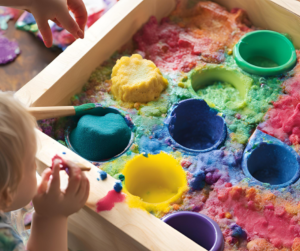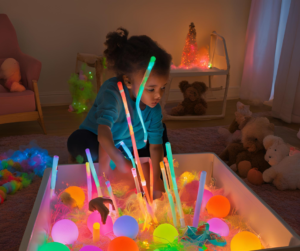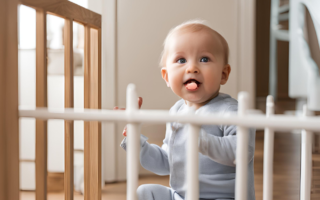This post will show you 20 Simple Sensory Bins for 12-Month-Olds
Sensory play is an essential part of early childhood development, and one of the simplest yet most effective ways to introduce this to your 12-month-old is through sensory bins. These hands-on activities stimulate a child’s senses, encouraging exploration, creativity, and learning.
But where do you start? If you’re looking for 20 simple sensory bins for 12-month-olds that are both fun and educational, you’re in the right place! In this blog, we’ll cover everything from why sensory play matters to practical tips on creating safe and engaging sensory bins for your little one.
WHY SENSORY PLAY IS IMPORTANT FOR 12-MONTHS-OLD
-
BOOSTS COGNITIVE DEVELOPMENT
At 12 months, babies are naturally curious. Sensory bins help them explore textures, colors, and sounds, enhancing their ability to process and understand the world around them.
-
IMPROVES MOTOR SKILLS
Manipulating small objects in a sensory bin supports both fine and gross motor skills. Grasping, scooping, and pouring are activities that strengthen hand-eye coordination.
-
ENCOURAGES CREATIVITY AND IMAGINATION
Sensory bins provide open-ended play opportunities, allowing toddlers to experiment and create their own stories as they interact with various materials.
-
CALMS AND FOCUSES
Interestingly, sensory play has a soothing effect on many children. It can help them concentrate and self-regulate their emotions.
20 SIMPLE SENSORY BINS FOR 12-MONTHS-OLD
-
RAINBOW RICE BIN

Introduce your child to vibrant colors with a rainbow rice bin. Simply dye uncooked rice with food coloring, let it dry, and add scoops and cups.
For an extra layer of fun, try hiding small toys in the rice and let your toddler “hunt” for them.
-
WATER PLAY BIN

Fill a shallow bin with water and include floating toys, sponges, and plastic cups. This bin is perfect for warm days and helps develop hand-eye coordination.
To make it even more engaging, incorporate colored ice cubes that melt as your child plays.
-
PASTA EXPLORATION BIN

Cooked or uncooked pasta works wonders in a sensory bin. Add a splash of food coloring to cooked pasta for a bright, squishy experience.
-
NATURE BIN

Collect leaves, sticks, pinecones, and small rocks from your yard. This bin introduces your little one to the textures of the natural world.
Next time you go for a walk, encourage your toddler to help gather items for the bin.
-
OATS AND CHEERIOS BIN

Combine uncooked oats with Cheerios for a safe, edible sensory bin. Add some scoops and small containers for sorting.
-
POM-POM BIN

Soft and colorful, pom-poms are a hit with toddlers. Add a variety of sizes and let your child sort or squish them.
Additionally, you can pair this bin with a muffin tin for color-sorting fun.
-
JELLY BIN

Create a gelatin-filled bin with small toys suspended inside. Your toddler will love squishing and digging through the jelly to find surprises.
-
SAND BIN

For an indoor sand experience, use kinetic sand. Add small shovels, rakes, and molds to enhance the fun.
-
FOAM PLAY BIN

Whip up a batch of foam using dish soap and water. Add a few drops of food coloring for a vibrant sensory experience.
Moreover, you can hide small toys in the foam for a treasure hunt.
-
SEASONAL SENSORY BIN

Tailor your sensory bin to the season! For example, use fake snow in winter, dried leaves in fall, or flowers in spring.
TIPS FOR CREATING SAFE AND ENGAGING SENSORY BINS
-
USE SAFE MATERIALS
Always choose non-toxic, age-appropriate materials for your bins. For 12-month-olds, edible items like rice, oats, and pasta are excellent choices.
-
SUPERVISE AT ALL TIMES
While sensory bins are generally safe, toddlers can be unpredictable. Always supervise play to prevent choking or other accidents.
-
KEEP IT SIMPLE
There’s no need for elaborate setups. Sometimes, the simplest materials provide the most enjoyment.
-
ENCOURAGE EXPLORATION
Allow your child to play freely without strict rules. Open-ended play fosters creativity and problem-solving skills.
-
ROTATE MATERIALS
To keep your toddler engaged, switch up the materials regularly. A fresh sensory bin feels like a new toy!
ADDITIONAL SENSORY BIN IDEAS
-
SHREDDED PAPER BIN

Use colorful shredded paper and add hidden toys for your toddler to find.
-
ICE AND WATER BIN

On hot days, an ice bin is a refreshing sensory experience. Add a few drops of food coloring for a visual treat.
-
BUBBLE WRAP BIN

Place bubble wrap in a bin along with small toys. The popping sensation is both fun and intriguing for little ones.
-
CEREAL BIN

Fill a bin with cereal like Cheerios or Fruit Loops. This edible option is perfect for safe play.
-
FRUIT SLICES BIN

Add slices of soft fruits like bananas and oranges. Not only is it sensory play, but it also introduces new flavors.
In addition to playing, let your toddler taste-test the fruits for added fun.
-
COTTON BALL BIN

Soft and fluffy, cotton balls are safe for toddlers. Add tongs or a spoon for scooping practice.
-
BUTTON BIN

Large buttons in various colors and sizes make for an exciting sorting activity.
-
PAINT AND SPONGE BIN

Fill a bin with non-toxic paint and small sponges. Encourage your toddler to explore texture and color blending.
-
GLOW-IN-THE-DARK BIN

Use glow sticks or glow-in-the-dark toys for a magical evening sensory bin.
-
MUSICAL BIN

Add small musical instruments like maracas, bells, and tambourines. Let your toddler explore sound and rhythm.
Sensory bins are a fantastic way to keep your 12-month-old engaged, entertained, and learning. By incorporating various textures, colors, and sounds, these simple setups provide endless opportunities for development and fun.
Remember, the key is to keep it safe, simple, and supervised. So why wait? Gather some materials today and start creating your own 20 simple sensory bins for 12-month-olds!
Not only will these activities bring joy to your little one, but they’ll also foster creativity, curiosity, and essential motor skills. Have fun exploring together!





